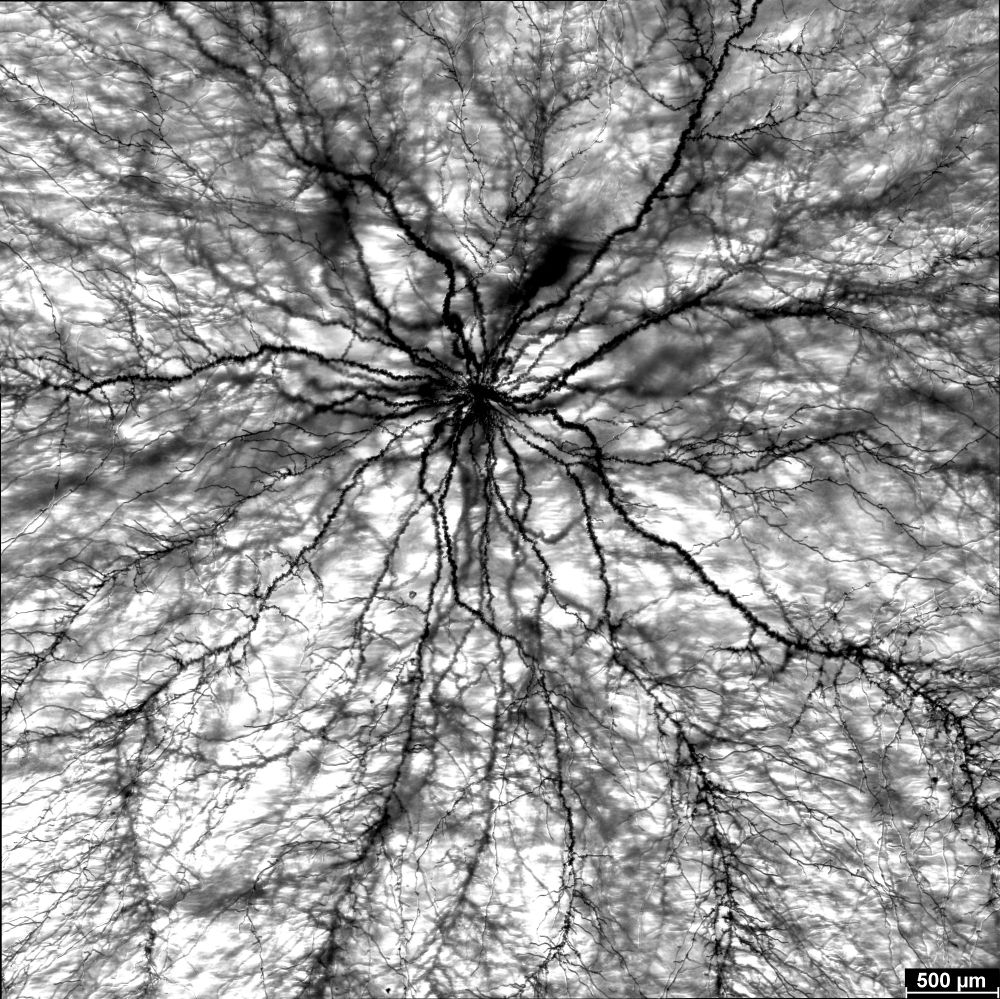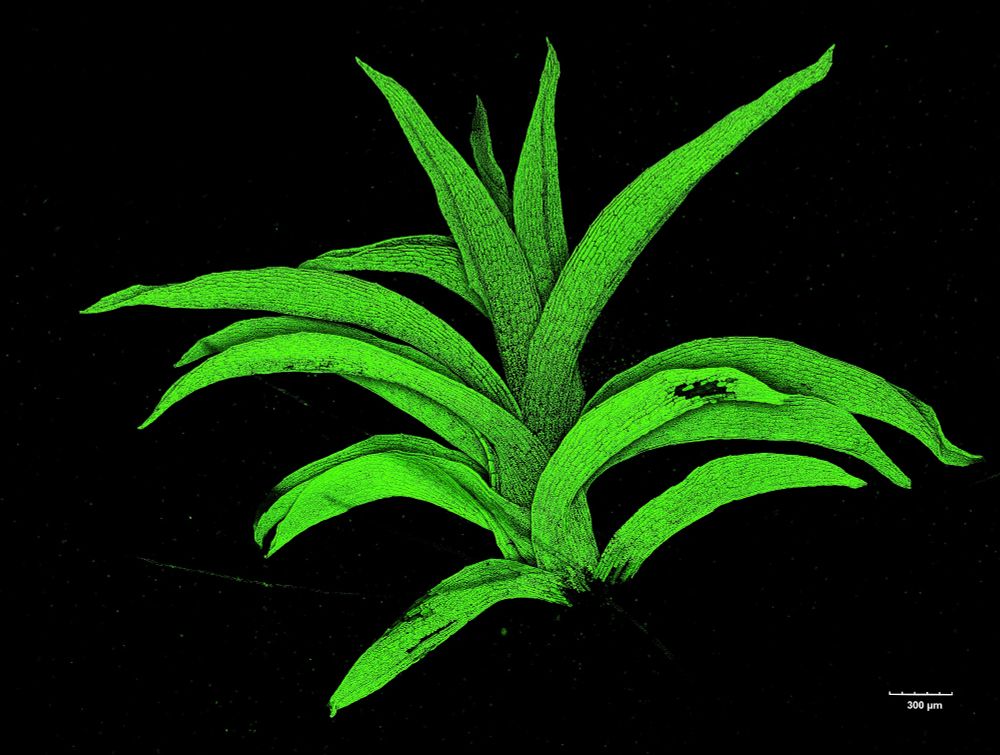
Lover of plants and microscopy.
Assistant Professor, Department of Plant and Microbial Biology, Univerisity of Minnesota.
Lab: radinlab.org/
Instagram: radinbio
These are two apical caulonemal cells from moss Physcomitrium patens stained with MDY64 (shown in shades of orange). The natural autofluorescence of chlorophyll is in cyan.
#microscopymonday #moss #plantcells #plantmicroscopy

These are two apical caulonemal cells from moss Physcomitrium patens stained with MDY64 (shown in shades of orange). The natural autofluorescence of chlorophyll is in cyan.
#microscopymonday #moss #plantcells #plantmicroscopy
These five Arabidopsis chloroplasts were extending their stromules (protrusions of the chloroplast envelope and stroma) towards each other.
#microscopymonday #Arabidopsis #plantcells #plantmicroscopy

These five Arabidopsis chloroplasts were extending their stromules (protrusions of the chloroplast envelope and stroma) towards each other.
#microscopymonday #Arabidopsis #plantcells #plantmicroscopy
You can see that the cell walls between cells are at an angle and not perpendicular to the cell axis.
#microscopymonday #moss #plantcells

You can see that the cell walls between cells are at an angle and not perpendicular to the cell axis.
#microscopymonday #moss #plantcells
Can you spot dividing chloroplasts?
#microscopymonday #moss #plantcells

Can you spot dividing chloroplasts?
#microscopymonday #moss #plantcells
#microscopymonday

#microscopymonday
These protoplasts were isolated from Arabidopsis and transformed with a vector to express cytosolic GFP (in orange). The chloroplast autofluorescence is in grey.
#microscopy

These protoplasts were isolated from Arabidopsis and transformed with a vector to express cytosolic GFP (in orange). The chloroplast autofluorescence is in grey.
#microscopy
This project was a great collaboration with Carl Procko from @salkinstitute.bsky.social. Videos were captured with the THUNDER Imager Model Organism dissecting scope from @leicamicrosystems.bsky.social
This project was a great collaboration with Carl Procko from @salkinstitute.bsky.social. Videos were captured with the THUNDER Imager Model Organism dissecting scope from @leicamicrosystems.bsky.social
doi: 10.1073/pnas.2206433119
doi: 10.1073/pnas.2206433119
If the touch is strong and large enough, a cytosolic calcium wave will spread from the site of touch throughout the whole plant, but if you only touch one tentacle (see post below), the calcium wave will be local and less intense.
If the touch is strong and large enough, a cytosolic calcium wave will spread from the site of touch throughout the whole plant, but if you only touch one tentacle (see post below), the calcium wave will be local and less intense.
#arabidopsis #cellbiology

#arabidopsis #cellbiology
#MicroscopyMonday

#MicroscopyMonday
In this dissecting microscope image, you can see the juvenile protonema filaments spread away from the main plant as they explore the new areas.
#MicroscopyMonday #Moss #Plants

In this dissecting microscope image, you can see the juvenile protonema filaments spread away from the main plant as they explore the new areas.
#MicroscopyMonday #Moss #Plants
Here we imaged the bottom side of the Arabidopsis thaliana leaf.
Here we imaged the bottom side of the Arabidopsis thaliana leaf.
#MicroscopyMonday #cellbiology #plastids

#MicroscopyMonday #cellbiology #plastids
Guess which leaf was infiltrated! #fluorescence

Guess which leaf was infiltrated! #fluorescence
#MicroscopyMonday #Fluoresence #CellBiology

#MicroscopyMonday #Fluoresence #CellBiology

I used Olympus FV3000 confocal and 60X/1.2W objective from Evident to make this Z stack, which was also subjected to deconvolution.


I used Olympus FV3000 confocal and 60X/1.2W objective from Evident to make this Z stack, which was also subjected to deconvolution.
#microscopymonday #cellbiology #plantmicroscopy #plant #moss

#microscopymonday #cellbiology #plantmicroscopy #plant #moss
This is a Z-stack through a chloroplast from a single Chlamydomonas reinhardtii cell. Signal = chlorophyll autofluorescence. The image was captured on AXR confocal from @healthcare.nikon.com with 100x/1.4 oil objective
#cellbiology #algae #microscopymonday
This is a Z-stack through a chloroplast from a single Chlamydomonas reinhardtii cell. Signal = chlorophyll autofluorescence. The image was captured on AXR confocal from @healthcare.nikon.com with 100x/1.4 oil objective
#cellbiology #algae #microscopymonday

This is a single gametophore with the accompanying rhizoids from moss Physcomitrium patens. The image was made with the Olympus SZX7 dissecting scope with a DP71 camera from Evident/Olympus.
#microscopymonday #moss

This is a single gametophore with the accompanying rhizoids from moss Physcomitrium patens. The image was made with the Olympus SZX7 dissecting scope with a DP71 camera from Evident/Olympus.
#microscopymonday #moss
.
.
.
This collage is a great example of the power of plant regeneration. Each of these individual 7-day-old moss (Physcomitrium patens) plants was regenerated from a single protoplast (a plant cell with removed cell walls).
#microscopymonday #moss

.
.
.
This collage is a great example of the power of plant regeneration. Each of these individual 7-day-old moss (Physcomitrium patens) plants was regenerated from a single protoplast (a plant cell with removed cell walls).
#microscopymonday #moss
And as a bonus, here is a 3D rendering of that Z-stack #3Dvolume
And as a bonus, here is a 3D rendering of that Z-stack #3Dvolume
#microscopymonday #plantcell #moss

#microscopymonday #plantcell #moss

